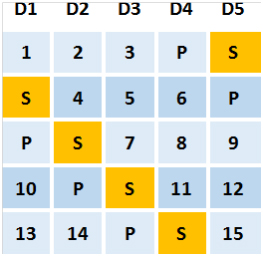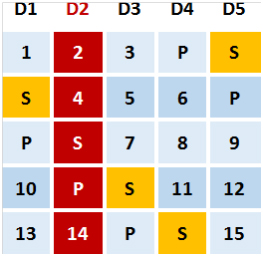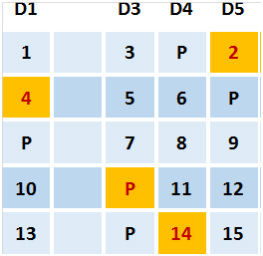RAID EE technology in Qsan storage
RAID algorithms have long been a universally accepted standard in the field of data storage, providing specified reliability and speed of access. Although RAID variations are not small, currently the main levels are levels 1, 5 and 6 (plus their combinations with zero level). But their further development in the form of RAID EE made it possible to increase their strengths as well as reduce some of the existing shortcomings.

In general, the idea of RAID EE is not new. And it has long been embodied in a number of controllers. Take at least enough popular RAID controllers from Adaptec. However, among data storage systems, the support of these algorithms is still very rare. Taiwan manufacturer Qsan Technology is just one of the few who have implemented RAID EE (starting with firmware version 1.3.0) in their products.
What is so good about RAID EE?
The main difference between the EE and traditional levels is the inclusion of a backup disk (or several disks at once) in the RAID group. That is, in other words, the data in the group is “smeared” not only by the main disks, but also by the Hot Spare disk (s) in such a way that each disk has free blocks, the total volume of which is equal to the volume of the disk (s) ” hot "reserve.
RAID EE can be used for classic levels 5 and 6, as well as their zero-level combinations (50, 60). For example, consider the block allocation scheme for the 5EE level of 4 disks plus Hot Spare.

In the diagram, P is a parity block, S is a Hot Spare block. For example, a disk 2 failed in a group.

As a result, blocks with data from disk 2 will be restored to Hot Spare blocks.

As soon as we replace the defective disk, the previously copied blocks will return to their place, and the Hot Spare blocks will again be available for the “hot” reserve.

For example, we can give the block allocation scheme for the 60EE level of 8 disks (2 groups of 2 + 2) and two Hot Spare disks.

Note that Qsan storage systems support up to 8 Hot Spare disks as part of a single EE RAID group, providing an unprecedented level of data protection.
Using Hot Spare disks in a group has several advantages over dedicated ones. First of all, it is that these disks are involved in read / write operations, thereby increasing the overall performance of the RAID group. Of course, the increase in access speed will not be impressive, but it is absolutely free.
The second and even more important point is a significant reduction in the rebuild time. If we consider the traditional levels of RAID 5 or 6, then in case of a disk failure, the process of restoring the missing blocks to a backup disk begins. At the same time, the write speed of the recovered blocks will rest on the performance of a single Hot Spare disc. Also, do not forget about the standard I / O operations while working with an array, which should be processed together with the recovery process. The more disks in a group and the higher the capacity of each disk, the longer the rebuild process will take. As a result, on capacious NL-SAS disks, the recovery process may take several days, during which the array is in the Degraded state.
In the case of using RAID EE, the rebuild process will be faster, because Hot Spare blocks are located on all disks of the group. And the process of writing to these blocks will occur in parallel. Of course, the recovery time will still depend on the size of the disk in the group and the current I / O activity. But the use of parallel writing to reserved areas on disks can significantly reduce the time the array is in the Degraded state. It is worth noting that the increase in Hot Spare disks in the RAID EE group can even further reduce recovery time due to greater parallelization of write operations to free blocks.
To verify the fact that the rebuild time was reduced, a series of tests was conducted. Specially used volume of a small volume of 100GB, so that you can get results in reasonable time.
The Qsan XS5224-D storage system was tested with an iSCSI interface connected to the server that created the load using the IOMeter. 24 x Seagate Constellation ES, ST500NM0001,500GB were used as disks.
Load profiles:
- Backup Pattern (Sequential Read / Write, 256KB (MB / s))
- Database Access Pattern (as defined by Intel / StorageReview.com, 8KB, 67% Read, 100% Random)
- File Server Access Pattern (as defined by Intel)
- Idle

RAID5 vs. RADI5 EE Comparison

RAID60 versus RADI60 EE
On the basis of the tests, it can be concluded that the implementation of RAID EE in Qsan storage systems really allows reducing the recovery time. But this statement is true only for those situations where the nature of the load is dominated by read operations.
Do not forget that during the rebuild, the probability of failure of other disks in the group due to the sharply increased load on them increases significantly. Therefore, reducing recovery time is one of the key parameters for data integrity. The ability to use RAID EE just allows you to improve this figure. But even greater efficiency can be achieved if you use RAID EE in Qsan storage systems in conjunction with another proprietary technology - Fast Rebuild , which copies only really busy data blocks. Proper storage space planning will eliminate potential problems in the future. And the rich arsenal of opportunities for this provided by the storage manufacturer will only increase the attractiveness of these storage systems in the eyes of the customer.
